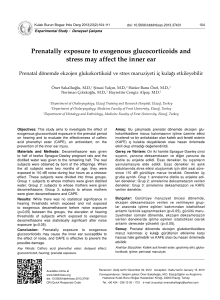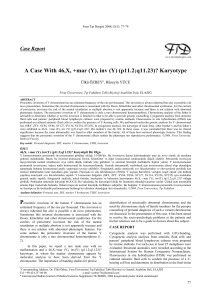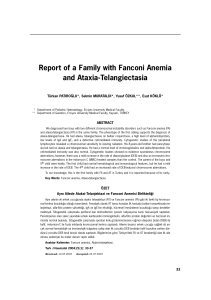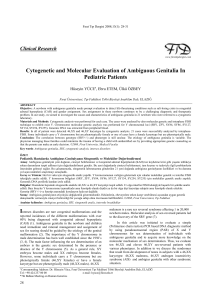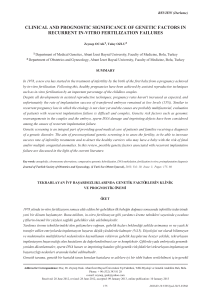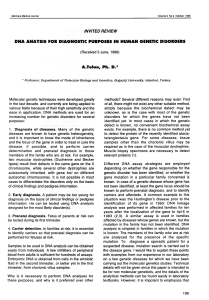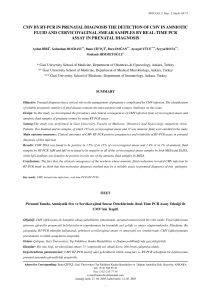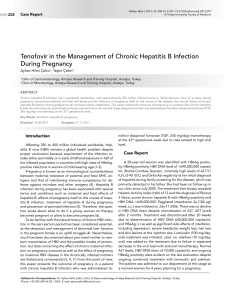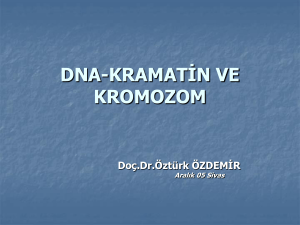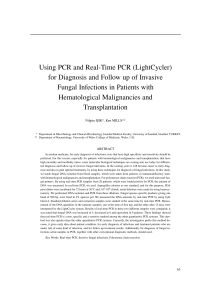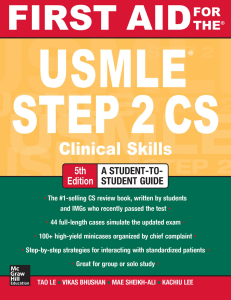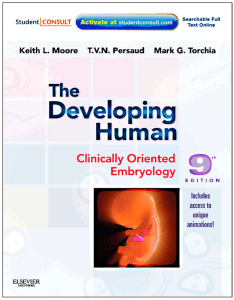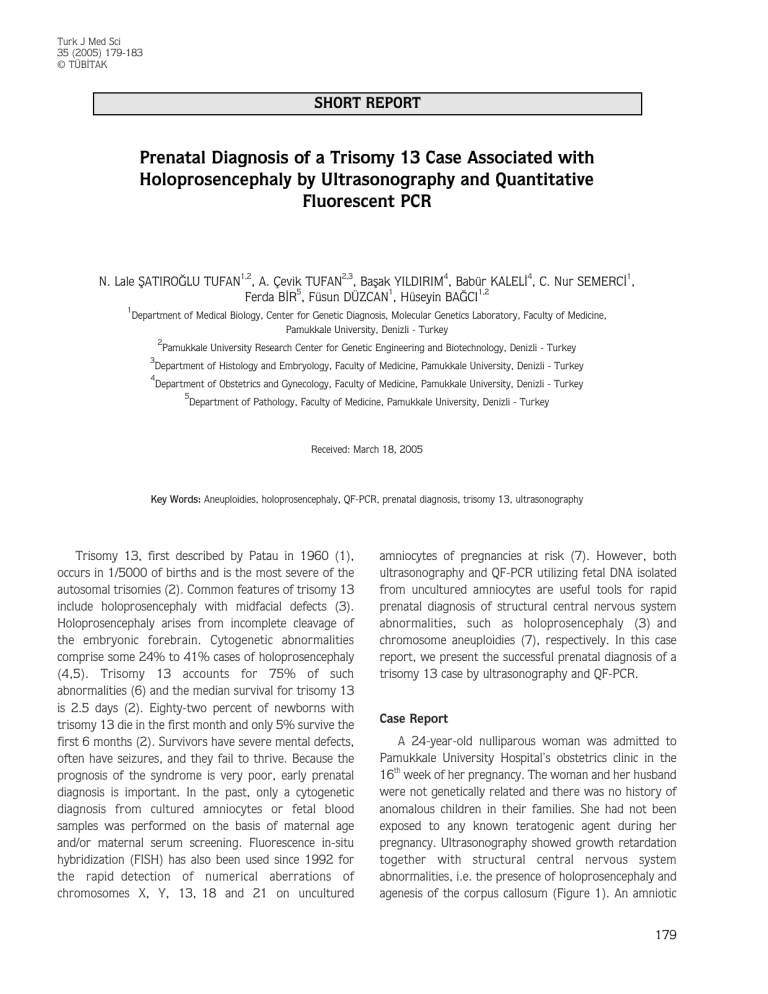
Turk J Med Sci
35 (2005) 179-183
© TÜB‹TAK
SHORT REPORT
Prenatal Diagnosis of a Trisomy 13 Case Associated with
Holoprosencephaly by Ultrasonography and Quantitative
Fluorescent PCR
N. Lale fiATIRO⁄LU TUFAN1,2, A. Çevik TUFAN2,3, Baflak YILDIRIM4, Babür KALEL‹4, C. Nur SEMERC‹1,
Ferda B‹R5, Füsun DÜZCAN1, Hüseyin BA⁄CI1,2
1
Department of Medical Biology, Center for Genetic Diagnosis, Molecular Genetics Laboratory, Faculty of Medicine,
Pamukkale University, Denizli - Turkey
2
Pamukkale University Research Center for Genetic Engineering and Biotechnology, Denizli - Turkey
3
Department of Histology and Embryology, Faculty of Medicine, Pamukkale University, Denizli - Turkey
4
Department of Obstetrics and Gynecology, Faculty of Medicine, Pamukkale University, Denizli - Turkey
5
Department of Pathology, Faculty of Medicine, Pamukkale University, Denizli - Turkey
Received: March 18, 2005
Key Words: Aneuploidies, holoprosencephaly, QF-PCR, prenatal diagnosis, trisomy 13, ultrasonography
Trisomy 13, first described by Patau in 1960 (1),
occurs in 1/5000 of births and is the most severe of the
autosomal trisomies (2). Common features of trisomy 13
include holoprosencephaly with midfacial defects (3).
Holoprosencephaly arises from incomplete cleavage of
the embryonic forebrain. Cytogenetic abnormalities
comprise some 24% to 41% cases of holoprosencephaly
(4,5). Trisomy 13 accounts for 75% of such
abnormalities (6) and the median survival for trisomy 13
is 2.5 days (2). Eighty-two percent of newborns with
trisomy 13 die in the first month and only 5% survive the
first 6 months (2). Survivors have severe mental defects,
often have seizures, and they fail to thrive. Because the
prognosis of the syndrome is very poor, early prenatal
diagnosis is important. In the past, only a cytogenetic
diagnosis from cultured amniocytes or fetal blood
samples was performed on the basis of maternal age
and/or maternal serum screening. Fluorescence in-situ
hybridization (FISH) has also been used since 1992 for
the rapid detection of numerical aberrations of
chromosomes X, Y, 13, 18 and 21 on uncultured
amniocytes of pregnancies at risk (7). However, both
ultrasonography and QF-PCR utilizing fetal DNA isolated
from uncultured amniocytes are useful tools for rapid
prenatal diagnosis of structural central nervous system
abnormalities, such as holoprosencephaly (3) and
chromosome aneuploidies (7), respectively. In this case
report, we present the successful prenatal diagnosis of a
trisomy 13 case by ultrasonography and QF-PCR.
Case Report
A 24-year-old nulliparous woman was admitted to
Pamukkale University Hospital’s obstetrics clinic in the
th
16 week of her pregnancy. The woman and her husband
were not genetically related and there was no history of
anomalous children in their families. She had not been
exposed to any known teratogenic agent during her
pregnancy. Ultrasonography showed growth retardation
together with structural central nervous system
abnormalities, i.e. the presence of holoprosencephaly and
agenesis of the corpus callosum (Figure 1). An amniotic
179
Prenatal Diagnosis of a Trisomy 13 Case Associated with Holoprosencephaly by Ultrasonography and Quantitative Fluorescent PCR
fluid sample and a fetal cord blood sample were obtained
for chromosome analysis during the termination of this
pregnancy.
QF-PCR and cytogenetic analysis
Figure 1. Ultrasonographic images, A, sagittal and B, coronal view,
confirming the alobar holoprosencephaly and agenesis of the
corpus callosum.
A rapid QF-PCR screening for common chromosome
aneuploidies, i.e. aneuploidies of chromosomes X, Y, 13,
18 and 21, from uncultured amniocytes was followed by
postmortem cytogenetic analysis of a fetal cord blood
sample. Genomic DNA was extracted from uncultured
amniocytes using the QIAamp blood kit (Qiagen). For sex
determination the unique sequence in the first intron of
the X/Y homologous gene amelogenin was amplified
(Table) (7). For the analysis of sex chromosomes and
common autosomal aneuploidies selected STR markers
were used per chromosome as listed in the Table (7). In
each primer pair for the different STR markers the
forward primer was labeled with FAM, a fluorescent dye
(Iontek), to enable the visualization and analysis of the
PCR product. PCR amplification was performed in a total
volume of 50 µl containing genomic DNA (10 µl of the
extracted DNA), 4–20 pmol of each primer, 25 µl of
HotStarTaq Master Mix (containing 2.5 units of
HotStarTaq DNA polymerase, 1x PCR Buffer with 1.5
mM MgCl2, and 200 µM of each dNTP; Qiagen, Hilden,
Germany). After the initial activation of HotStarTaq DNA
polymerase at 94 °C for 15 min, 31 cycles of PCR
amplification followed (1 min denaturation at 94 °C, 1
Table. Primers and short tandem repeat markers (STRs) used for sexing and for the detection of sex chromosome
and common autosomal aneuploidies.
Chromosome
X chromosome marker
DXS8337-F-FAM
DXS8337-R
Chromosome 13 marker
D13S258-F-FAM
D13S258-R
Chromosome 18 marker
D18S1002-F-FAM
D18S1002-R
Chromosome 21 marker
D21S1411-F-FAM
D21S1411-R
Amelogenin locus
HUMAMG-F-FAM
HUMAMG-R
Marker primer sequence (5’-3’)
Expected fragment size (bp)
FAM-CACTTCATGGCTTACCACAG
GACCTTTGGAAAGCTAGTGT
203-245
FAM-ACCTGCCAAATTTTACCAGG
GACAGAGAGAGGGAATAAACC
180-296
FAM-CAAAGAGTGAATGCTGTACAAACAGC
CAAGATGTGAGTGTGCTTTTCAGGAG
286-318
FAM-ATGATGAATGCATAGATGGATG
AATGTGTGTCCTTCCAGGC
283-313
FAM-CCCTGGGCTCTGTAAAGAATAGTG
ATCAGAGCTTAAACTGGGAAGCTG
106X;112Y
F = forward primer; R = reverse primer.
180
N. L. fiATIRO⁄LU TUFAN, A. Ç. TUFAN, B. YILDIRIM, B. KALEL‹, C. N. SEMERC‹, F. B‹R, F. DÜZCAN, H. BA⁄CI
min annealing at 60 °C, 1 min extension at 72 °C, final
extension for 5 min at 72 °C) performed in a Hybaid PCR
Sprint Temperature Cycling System. The amplified allelic
fragments were resolved on a denaturing polyacrylamide
gel using a DNA sequencer and the GeneScan software
was employed for the analysis and calculation of these
products (Iontek). The results of QF-PCR screening
obtained within 24-48 h of amniocentesis (Figure 2B-F)
were in complete concordance with those of postmortem
cytogenetic analysis (Figure 3), which revealed a
(47,XX,+13) karyotype. QF-PCR analysis of maternal
DNA isolated from maternal leukocytes for chromosome
13 using the same STR marker primers showed 2
allelic fragments (Figure 2A) completely overlapping
with 2 out of the 3 allelic fragments observed in the fetus
for chromosome 13 (Figure 2B), suggesting the
nondisjunction of maternal chromosome 13 homologues
at meiosis I as the cause of trisomy 13 in this fetus.
A. Maternal Ch.13
120
80
40
0
245 bp
239 bp
B. Fetal Ch.13
150
100
50
0
245 bp
239 bp
243 bp
C. Fetal Ch.18
150
100
50
0
292 bp
296 bp
D. Fetal Ch.21
150
100
50
0
Autopsy report
A complete autopsy was performed, revealing a 68 g
female fetus, with a crown-rump length of 10 cm, and a
crown-heel length of 15 cm. Macroscopic examination of
the head and face revealed hypotelorism, a proboscis-like
single nostril, a short philtrum, and low auricles (Figure
4A). The extremities, hands, feet, fingers and toes were
all normal. Bilateral simian lines were present.
Craniotomy revealed alobar holoprosencephaly and the
absence of cerebellum (Figure 4B). Cerebral weight was
3.4 g. The pons, medulla oblongata and medulla spinalis
were normal in appearance. Dissection of the cerebral
tissue revealed the absence of corpus callosum, and a
single dilated ventricle (Figure 4C). All organs within the
chest and abdominal cavities were normal, except for the
fact that no uterus, uterine tubes, or ovaries were
observed. The plasenta and its associated membranes
were normal; however, the umblical cord contained 2
blood vessels, i.e. a single artery and a single vein. Thus,
the autopsy findings were supportive of the trisomy 13
karyotype and confirmed the findings of the
ultrasonography report.
The presented growth retarded fetus with
holoprosencephaly and agenesis of the corpus callosum is
a classical example showing the importance of traditional
mid-second trimester obstetric ultrasound scanning
during pregnancy. The common ultrasonographic
features of trisomy 13 include holoprosencephaly, facial
289 bp
293 bp
E. Fetal X Ch.
150
100
50
0
223 bp
241 bp
F. Fetal Amelogenin
90
60
30
0
106 bp
Figure 2. Analysis of chromosomes 13, 18, 21, X and Y by QF-PCR
utilizing DNA extracted from uncultured amniocytes revealed
a female fetus with trisomy 13 (B-F). QF-PCR analysis of
maternal DNA isolated from maternal leukocytes for
chromosome 13 using the same STR marker primer pair
showed 2 allelic fragments (A) completely overlapping with 2
out of 3 allelic fragments observed in the fetus for
chromosome 13 (B, overlapping fragments are indicated
with arrows and the extra third fragment is indicated with an
arrow head). Numbers on x-axes represent fragment length
in base pairs (bp), whereas numbers on y-axes are arbitrary
units.
181
Prenatal Diagnosis of a Trisomy 13 Case Associated with Holoprosencephaly by Ultrasonography and Quantitative Fluorescent PCR
1
2
3
6
7
8
13*
14
15
19
20
4
9
21
5
10
11
12
16
17
18
22
X
Y
Figure 3. Cytogenetic analysis results of the fetus confirming the (47,
XX, +13) karyotype.
Figure 4. Autopsy images of the fetus. Macroscopic examination of the
head and face revealed hypotelorism, a proboscis-like single
nostril, a short philtrum, and low auricles (A). Craniotomy
revealed alobar holoprosencephaly and the absence of
cerebellum (B). Dissection of the cerebral tissue revealed the
absence of corpus callosum, and a single dilated ventricle (C).
clefts, cardiac defects, intrauterine growth retardation,
microcephaly, neural tube defects, omphalocele,
polycystic kidneys, and polydactyly (3). Intracranial
anomalies include abnormal posterior fossa, agenesis of
the corpus callosum, and ventriculomegaly (3). Thus,
chromosomal analysis has to be recommended in all cases
with such ultrasonographic features diagnosed prenatally,
helping to determine the etiology of these defects and
providing accurate recurrence risks for the families in
subsequent pregnancies.
Karyotyping, the traditional “gold standard” method,
is carried out on cultured cells at the metaphase stage of
the cell cycle when the chromosomes are optimally
182
condensed and this technique identifies a wide range of
chromosomal abnormalities, including aneuploidies,
translocations and inversions. However, the long waiting
period for karyotype results (about 2 weeks) may cause
a great deal of stress for the parents during the prenatal
diagnosis of common chromosome disorders and this has
been one of the main reasons for the initiation of
molecular methods (8-11). The 2 most common
molecular methods for prenatal diagnosis of chromosome
disorders are FISH and QF-PCR, which are applied to fetal
nondividing cells obtained by amniocentesis and/or CVS
and the results can be delivered within 1-2 days. These
methods allow rapid and simple yet reliable prenatal
diagnosis of targeted fetal chromosome disorders
including trisomy 13, 18, 21 and some sex chromosome
abnormalities (9). FISH employs hybridization of selected
chromosome-specific DNA sequences that have been
labeled with fluorescent dyes to chromosome
preparations, which are visualized under the fluorescence
microscope. It requires 1.0-1.5 ml of amniotic fluid for
the aneuploidy diagnosis and spot counting is the most
time-consuming part of the interphase FISH procedure
(about 30 min per sample). On the other hand, QF-PCR
involves DNA isolation from the sample (0.5-1.0 ml) and
the amplification of chromosome-specific, repeated DNA
sequences named STRs using fluorescent primers by PCR
and the products are visualized/quantified using an
automated DNA sequencer with the GeneScan software.
The QF-PCR analysis carried out by GeneScan takes about
5 min per sample and it lends itself more easily to
automation than does FISH. The most important step of
the QF-PCR setup concerns the optimization of the
primers used. The risk of misdiagnosis with QF-PCR and
FISH has been reported as acceptably low (8-14). One of
the disadvantages of FISH is that maternal and fetal XX
cells per se are indistinguishable by FISH, rendering
maternal cell contamination undetectable from female
fetuses. In contrast, maternal cell contamination is easily
detected by QF–PCR, showing a characteristic pattern
with extra alleles or skewed ratios between peaks for the
target chromosomes (8-14).
The importance of this case was the successful use of
QF-PCR for the rapid and accurate diagnosis of trisomy
13 in conjunction with cytogenetic analysis. In cases like
this with features suggesting a common chromosomal
aneuploidy, QF-PCR provides a rapid, cost efficient, and
dependable choice for prenatal testing (8-14). Although
QF-PCR has been used as a preamble to full chromosome
N. L. fiATIRO⁄LU TUFAN, A. Ç. TUFAN, B. YILDIRIM, B. KALEL‹, C. N. SEMERC‹, F. B‹R, F. DÜZCAN, H. BA⁄CI
analysis by microscopy or for pure research purposes,
there is a debate over whether to apply this test as a
‘stand-alone’ test for women who are offered
amniocentesis due to advanced maternal age and/or
maternal serum screening results (8-14). These women
comprise the majority of subjects who are at risk of
having a baby with a common aneuploidy (8). If
introduced on a larger scale, the use of QF-PCR would
lead to substantial time, labor, and financial savings in the
prenatal testing of suggested risk groups (9-14). In
addition, QF-PCR analysis of maternal DNA in comparison
to that of fetal DNA for chromosome 13 suggested that
the possible cause of trisomy 13 in this fetus was the
nondisjunction of maternal chromosome 13 homologues
at meiosis I. Thus, the case presented here represents an
excellent pilot study of how QF-PCR can be utilized in the
rapid prenatal diagnosis of common aneuploidies in a
clinical setting.
Acknowledgment
The authors thank Dr. Onur Bileno¤lu from Iontek
Ltd. Sti. (‹stanbul, Turkey) for his technical support with
the GeneScan analysis of PCR products.
Corresponding author:
N. Lale fiATIRO⁄LU TUFAN
Department of Medical Biology,
Center for Genetic Diagnosis,
Molecular Genetics Laboratory,
Faculty of Medicine,
Pamukkale University,
Denizli - Turkey
E-mail: [email protected]
References
1.
Patau K. Multiple congenital anomaly caused by an extra
chromosome. Lancet 1: 790-795, 1960.
2.
Jones ICL. Smith’s recognizable patterns of human malformation.
Saunders. Philadelphia-London 1997, pp: 18-19.
3.
Tongsong T, Sirichotiyakul S, Wanapirak C et al. Sonographic
features of trisomy 13 at midpregnancy. Int J Gynaecol Obstet
76: 143-148, 2002.
4.
Croen LA, Shaw GM, Lammer EJ. Holoprosencephaly:
epidemiologic and clinical characteristics of a California
population. Am J Med Genet 64: 465–472, 1996.
5.
Oslen CL, Hughes JP, Youngblood LG et al. Epidemiology of
holoprosencephaly and phenotypic characteristics of affected
children: New York State, 1984–1989. Am J Med Genet 73:
217–226, 1997.
6.
Phadke SR, Thakur S. Prenatal diagnosis of iniencephaly and
alobar holoprosencephaly with trisomy 13 mosaicism: a case
report. Prenat Diagn 22: 1240-1241, 2002.
7.
Schmidt W, Jenderny J, Hecher K et al. Detection of aneuploidy
in chromosomes X, Y, 13, 18 and 21 by QF-PCR in 662 selected
pregnancies at risk. Mol Hum Reprod 6: 855-860, 2000.
8.
Hulten MA, Dhanjal S, Pertl B. Rapid and simple prenatal
diagnosis of common chromosome disorders: advantages and
disadvantages of the molecular methods FISH and QF-PCR.
Reproduction 126: 279-297, 2003.
9.
Cirigliano V, Voglino G, Canadas MP et al. Rapid prenatal
diagnosis of common chromosome aneuploidies by QF-PCR.
Assessment on 18,000 consecutive clinical samples. Mol Hum
Reprod 10: 839-846, 2004.
10.
Mann K, Donaghue C, Fox SP et al. Strategies for the rapid
prenatal diagnosis of chromosome aneuploidy. Eur J Hum Genet
12: 907-15, 2004.
11.
Ogilvie CM, Donaghue C, Fox SP et al. Rapid prenatal diagnosis of
aneuploidy using quantitative fluorescence-PCR (QF-PCR). J
Histochem Cytochem 3: 285-8, 2005.
12.
Nicolini U, Lalatta F, Natacci F et al. The introduction of QF-PCR
in prenatal diagnosis of fetal aneuploidies: time for
reconsideration. Hum Reprod Update 10: 541-8, 2004.
13.
Leung WC, Waters JJ, Chitty L. Prenatal diagnosis by rapid
aneuploidy detection and karyotyping: a prospective study of the
role of ultrasound in 1589 second-trimester amniocenteses.
Prenat Diagn. 24: 790-5, 2004.
14.
Quaife R, Wong LF, Tan SY et al. QF-PCR-based prenatal
detection of aneuploidy in a southeast Asian population. Prenat
Diagn 24: 407-13, 2004.
183

